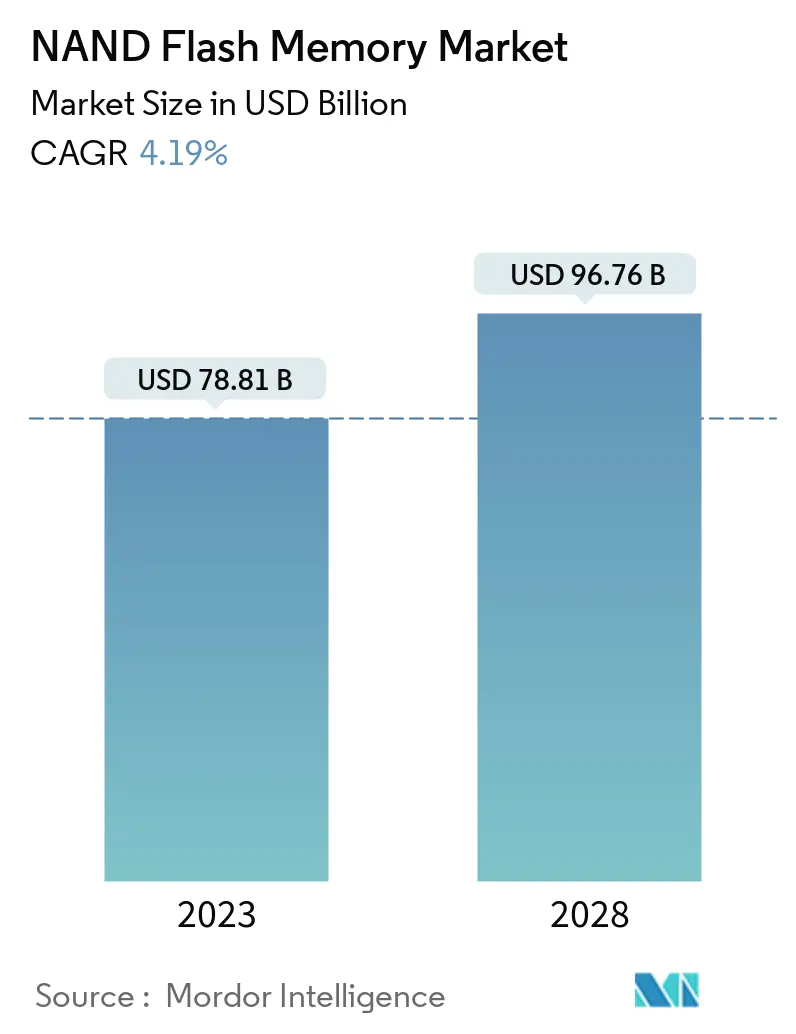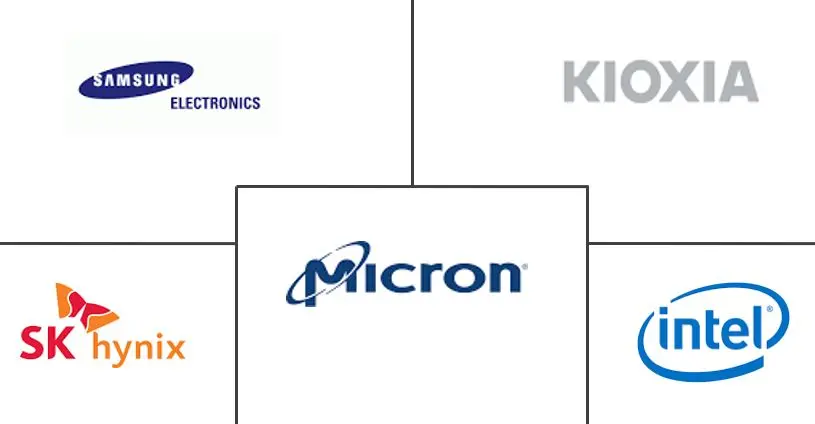Market Size of NAND Flash Memory Industry

| Study Period | 2018 - 2028 |
| Market Size (2023) | USD 50.14 Billion |
| Market Size (2028) | USD 65.32 Billion |
| CAGR (2023 - 2028) | 5.43 % |
| Fastest Growing Market | Asia Pacific |
| Largest Market | Asia Pacific |
Major Players
*Disclaimer: Major Players sorted in no particular order |
Need a report that reflects how COVID-19 has impacted this market and its growth?
NAND Flash Memory Market Analysis
The NAND Flash Memory Market size is expected to grow from USD 50.14 billion in 2023 to USD 65.32 billion by 2028, at a CAGR of 5.43% during the forecast period (2023-2028).
- With the rise of PCs and smartphones, NAND flash consumption is dramatically increasing, much of which is attributed to the growth of the average capacity of smartphones. This is expected to drive the demand for NAND flash packaging, thus influencing the demand for memory packaging.
- According to Micron, an average smartphone contains 43 GB of NAND flash storage, and it is expected to grow substantially over the next four years. The company estimated that, by 2021, an average phone would have 142 GB of NAND flash storage, with flagship devices having one terabyte of flash storage.
- Other consumer products such as tablets and cameras, along with industrial equipment and sensors, automotive systems, and medical devices, rely upon flash memory, which is integrated alongside their processors, and stores both data and the code they execute. As demand for massive data processing for artificial intelligence and machine learning applications grows, the trend for flash-based storage will continue to evolve.
- Production of China-based NAND flash vendors was not severely affected by the outbreak of novel COVID-19. This is because the plants are highly automated, have relatively low demands for manpower, and operators are also stocked up with raw materials before the Chinese Lunar New Year. Foundry output was delivered to customers in China because semiconductor fabrication plants hold national special licenses. These allow them to ship their products throughout domestic China, even with cities under quarantine.
- The electronics device sector was anticipated to be impacted significantly by the COVID-19 outbreak, as China is one of the major suppliers of raw materials and finished products. The industry faced a reduction in production, disruption in the supply chain, and price fluctuations. The sales of prominent electronic companies were affected during the period. The travel restriction on both people and products hampered the market's growth in the short run.
NAND Flash Memory Industry Segmentation
NAND flash is a kind of non-volatile storage technology that does not require power to retain data. In other words, it is a form of electronically erasable programmable read-only memory (EEPROM). It is programmed, erased, and reprogrammed in large blocks. It's called NAND because, at the circuit level, it's similar to the NAND logic function. The scope of the study covers the market on the basis of the type of NAND and different applications in smartphones, SSD, Memory Card, and Tablet PC across the globe.
The NAND flash memory market is segmented by type (SLC, MLC, and TLC), structure (2-D structure and 3-D structure), application (smartphones, SSD, memory cards, and tablets), and geography.
| Type | |
| SLC (One-Bit Per Cell) | |
| MLC (Two-Bit Per Cell) | |
| TLC (Three-Bit Per Cell) | |
| QLC (Quad Level Cell) |
| Structure | |
| 2D Structure | |
| 3D Structure |
| Application | |
| Smartphone | |
| SSD | |
| Memory Card | |
| Tablet | |
| Other Applications |
| Geography | |
| North America | |
| Europe | |
| Asia Pacific | |
| Latin America | |
| Middle-East and Africa |
NAND Flash Memory Market Size Summary
The NAND Flash Memory Market is experiencing significant growth, primarily driven by the rise of PCs and smartphones. The increasing average capacity of smartphones is leading to a surge in NAND flash consumption, thus boosting the demand for NAND flash packaging and memory packaging. Factors such as growing investments in fabrication facilities, market growth through edge storage, and the increasing need for high-density storage to support smartphone applications are also contributing to the market expansion. Additionally, the rising demand for 3D NAND has created opportunities for supply chain members, leading to increased investments in 3D NAND fabrication facilities. Despite the impact of the COVID-19 outbreak on the electronics device sector, the production of NAND flash vendors in China was not severely affected, thanks to the high level of automation in plants and sufficient stock of raw materials. The market is also witnessing significant growth in the smartphone segment, with NAND flash memory enhancing the performance of various smartphone functions. The advent of 5G technology is expected to further increase the use of smartphones, thereby boosting the demand for NAND flash memory. In the Asia-Pacific region, the high demand for NAND flash memories is being driven by the growing smartphone usage in developing countries and the high activity from semiconductor fabrication facilities.
Explore MoreNAND Flash Memory Market Size - Table of Contents
-
1. MARKET DYNAMICS
-
1.1 Market Overview
-
1.2 Industry Attractiveness - Porter's Five Forces Analysis
-
1.2.1 Bargaining Power of Suppliers
-
1.2.2 Bargaining Power of Buyers
-
1.2.3 Threat of New Entrants
-
1.2.4 Threat of Substitutes
-
1.2.5 Intensity of Competitive Rivalry
-
-
1.3 Industry Value Chain Analysis
-
1.4 Assessment of Impact of COVID-19 on the Industry
-
1.5 Market Drivers
-
1.5.1 Increasing Demand for Data Centers
-
1.5.2 Increasing Proliferation of 5G and IOT Devices
-
-
1.6 Market Restraints
-
1.6.1 Reliability Issues
-
-
-
2. MARKET SEGMENTATION
-
2.1 Type
-
2.1.1 SLC (One-Bit Per Cell)
-
2.1.2 MLC (Two-Bit Per Cell)
-
2.1.3 TLC (Three-Bit Per Cell)
-
2.1.4 QLC (Quad Level Cell)
-
-
2.2 Structure
-
2.2.1 2D Structure
-
2.2.2 3D Structure
-
-
2.3 Application
-
2.3.1 Smartphone
-
2.3.2 SSD
-
2.3.3 Memory Card
-
2.3.4 Tablet
-
2.3.5 Other Applications
-
-
2.4 Geography
-
2.4.1 North America
-
2.4.2 Europe
-
2.4.3 Asia Pacific
-
2.4.4 Latin America
-
2.4.5 Middle-East and Africa
-
-
NAND Flash Memory Market Size FAQs
How big is the NAND Flash Memory Market?
The NAND Flash Memory Market size is expected to reach USD 50.14 billion in 2023 and grow at a CAGR of 5.43% to reach USD 65.32 billion by 2028.
What is the current NAND Flash Memory Market size?
In 2023, the NAND Flash Memory Market size is expected to reach USD 50.14 billion.
